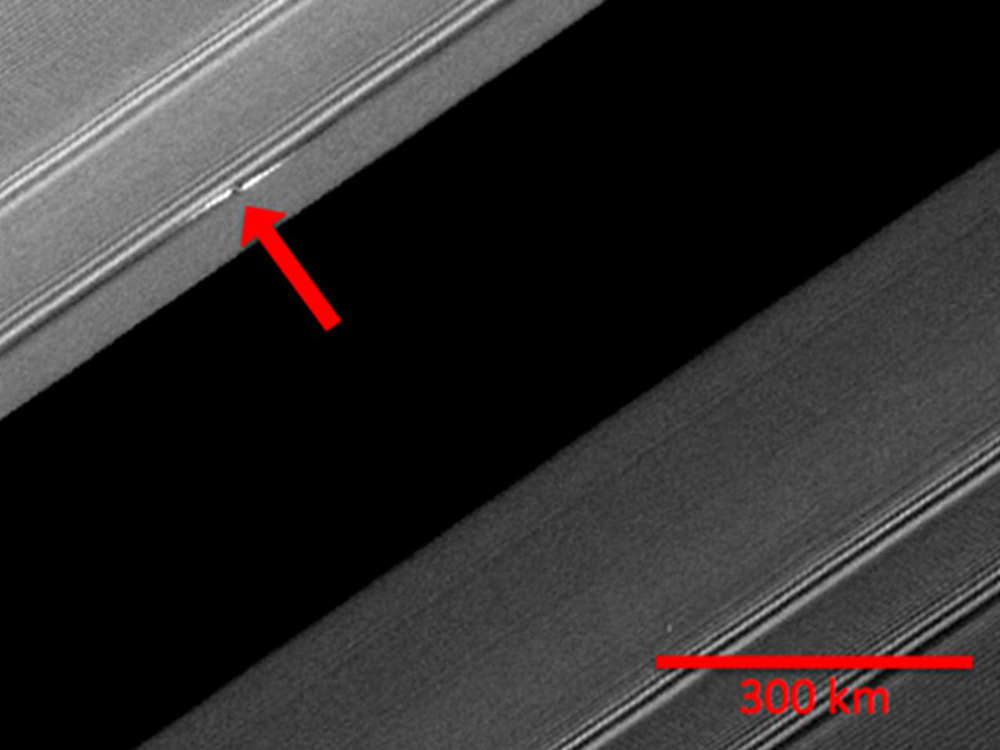Giant Propellers Discovered In Saturn's Rings

Giantpropeller-shaped structures have been discovered in the rings of Saturn and appearto be created by a new class of hidden moons, NASA announced Thursday.
NASA'sCassini spacecraft spotted the distinctive structures inside some of Saturn's rings, marking the first time scientists havemanaged to track the orbits of individual objects from within a debris disklike the one that makes up Saturn's complicated ring system.
"Observingthe motions of these disk-embedded objects provides a rare opportunity to gaugehow the planets grew from, and interacted with, the disk of materialsurrounding the early sun," said the study's co-author Carolyn Porco, oneof the lead researchers on the Cassini imaging team based at the Space ScienceInstitute in Boulder, Colo. "It allows us a glimpse into how the solarsystem ended up looking the way it does."
Photos ofthe propellers taken by Cassini show them to be huge structures severalthousands of miles long. By understanding how they form, astronomers hope toglean insight into the debris disks around other stars as well, researcherssaid.?
The resultsof the study are detailed in the July 8 issue of the journal AstrophysicalJournal Letters.?
Propellersat Saturn
Cassiniscientists have seen double-armed propeller structures in Saturn's ringsbefore, but on a smaller scale than the larger, newfound features. They werefirst spotted in 2006 in an area now known as the "propeller belt,"which is located in the middle of Saturn's outermost dense ring ? the A ring.
Breaking space news, the latest updates on rocket launches, skywatching events and more!
The propellersare actually gaps in the ring material were created by a new class of objects,called moonlets, that are smaller than known moons but larger than theparticles making up Saturn's rings. It is estimated that these moonlets couldnumber in the millions, according to Cassini scientists.
The moonletsclear the space immediately around them to generate the propeller-like features,but are not large enough to sweep clear their entire orbit around Saturn, asseen with the moons Pan and Daphnis. [Photos of Saturn rings and moons.]
But in thenew study, researchers a new legion of larger and rarer moons in a separatepart of the A ring, farther out from Saturn. These much larger moons createpropellers that are hundreds of times larger than those previously described,and these objects have been tracked for about four years.
The studywas led by Cassini imaging team associate Matthew Tiscareno at CornellUniversity in Ithaca, N.Y.
Thepropeller features for these larger moons are up to thousands of miles long andseveral miles wide. The moons embedded in Saturn's rings appear to kick up ringmaterial as high as 1,600 feet (0.5 km) above and below the ring plane.
This is muchgreater than the typical ring thickness of about 30 feet (10 meters),researchers said.
HiddenSaturn moons
Still, the Cassini spacecraft is too far away to see the moons amid the swirling ring material thatsurrounds them. Yet, scientists estimate that the moons measure approximatelyhalf a mile (about one km) in diameter, based on the size of the propellers.
According totheir research, Tiscareno and his colleagues estimate that there are dozens ofthese giant propellers. In fact, 11 of them were imaged multiple times between2005 and 2009.
One suchpropeller, nicknamed Bleriot after the famous aviator Louis Bleriot, has shownup in more than 100 separate Cassini images and one ultraviolet imagingspectrograph observation during this time.
"Scientistshave never tracked disk-embedded objects anywhere in the universe beforenow," said Tiscareno. "All the moons and planets we knew about beforeorbit in empty space. In the propeller belts, we saw a swarm in one image andthen had no idea later on if we were seeing the same individual objects. Withthis new discovery, we can now track disk-embedded moons individually over manyyears."
Overtheir four years of observation, the researchers noticed shifts in the orbitsof the giant propellers as they travel around Saturn, but the cause of thesedisturbances have not yet been determined.
Theshifting orbits could be caused by collisions with other smaller ringparticles, or could be responses to these particles' gravity, the researcherssaid. The orbital paths of these moonlets could also be altered due to thegravitational attraction of large moons outside of Saturn's rings.
Scientistswill continue to monitor the moons to see if the disk itself is driving thechances, similar to the interactions that occur in young solar systems. If so,Tiscareno said, this would be the first time such a measurement has been madedirectly.
"Propellersgive us unexpected insight into the larger objects in the rings," saidLinda Spilker, Cassini project scientist based at NASA's Jet PropulsionLaboratory in Pasadena, Calif. "Over the next seven years, Cassini willhave the opportunity to watch the evolution of these objects and to figure outwhy their orbits are changing."
NASAlaunched the Cassini probe in 1997 and it arrived at Saturn in 2004, where it dropped the European Huygens probe on the cloudysurface of Titan, Saturn's largest moon. Cassini was slated to bedecommissioned in September of this year, but received a life extension thatnow runs through 2017.
- Gallery - The Rings and Moons of Saturn
- Cassini's Greatest Hits: Images of Saturn
- Special Report: Cassini's Mission to Saturn

Denise Chow is a former Space.com staff writer who then worked as assistant managing editor at Live Science before moving to NBC News as a science reporter, where she focuses on general science and climate change. She spent two years with Space.com, writing about rocket launches and covering NASA's final three space shuttle missions, before joining the Live Science team in 2013. A Canadian transplant, Denise has a bachelor's degree from the University of Toronto, and a master's degree in journalism from New York University. At NBC News, Denise covers general science and climate change.
